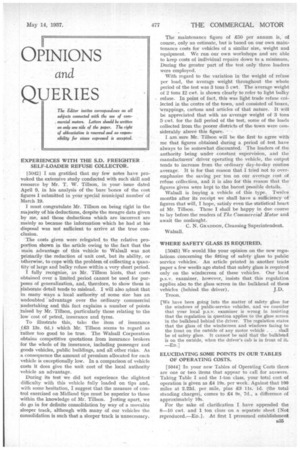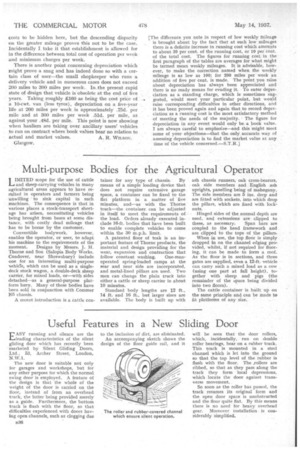EXPERIENCES WITH THE S.D. FREIGHTER SELF-LOADER REFUSE COLLECTOR.
Page 45

Page 46

If you've noticed an error in this article please click here to report it so we can fix it.
[5042] I am gratified that my few notes have provoked the extensive study conducted with such skill and resource by Mr. T. W. Tillson, in your, issue dated April 9, in his analysis of the bare bones of the cost figures I submitted in your special municipal number of March 19.
I must congratulate Mr. Tillson on being right in the majority of his deductions, despite the meagre data given by me, and those deductions which are incorrect are mainly so because the information which he had at his disposal was not sufficient to arrive at the true conclusion.
• The costs given were relegated to the relative proportion shown in the article owing to the fact that the main advantage of this vehicle to Walsall was not primarily the reduction of unit cost, but its ability, or Otherwise, to cope with the problem of collecting a quantity of large and bulky refuse within a very short period.
I fully recognize, as Mr. Tillson hints, that costs obtained over a limited period cannot be used for purposes of generalization, and, therefore, to show them in islaborate detail tends to mislead. I will also admit that in many ways a local authority of some size has an undoubted advantage over the ordinary commercial imdertaking and this fact explains a number of points raised by Mr. Tillson, particularly those relating to the low cost of petrol, insurance and tyres.
To illustrate this, take the item of insurance ,(£3 13s. 6d.) which Mr. Tills= seemsto regard as rather too good to be true. The Walsall Corporation obtains competitive quotations from insurance brokers for the whole of its insurance, including passenger and goods vehicles, public buildings, and all other risks. As a consequence the amount of premium allocated for each vehicle is exceptionally low. In a comparison of vehicle costs it does give the unit cost of the local authority vehicle an advantage.
During its test we did not experience the slightest difficulty with this vehicle fully loaded on tips and, with some hesitation, I suggest that the measure of control exercised on Midland tips must be superior to those within the knowledge of Mr. Tillson.. Jesting apart, we do go in for definite consolidation by way of a movable sleeper track, although with many of our vehicles the consolidation is such that a sleeper track is unnecessary.
The maintenance figure of per annum is, of course, only an estimate, but is based on our own maintenance costs for vehicles of a similar size, weight and equipment. We run our own workshops and are able to keep costs of individual repairs down to a minimum. During the greater part of the test only three loaders were employed.
With regard to the variation in the weight of refuse per load, the average weight throughout the whole period of the test was 3 tons 5 cwt. The average weight of 2 tons 12 cwt, is shown clearly to refer to light bulky refuse. In point of fact, this was light trade refuse collected in the centre of the town, and consisted of boxes, -wrappings, cartons and articles of that nature. It will be appreciated that with an average weight of 3 tons 5 cwt. for the full period of the test, some of the loads collected from the poorer districts of the town were considerably above this figure. — .am sure Mr. Tillson will be the first to agree with me that figures obtained during a period of test have always to be somewhat discounted. The loaders of the authority being under constant supervision, and the Manufacturers' driver operating the vehicle, the output tends to increase from the ordinary day-to-day routine average. It is for that reason that I tried not to overemphasize the saving per ton on our average cost of refuse collection, and it is also for this reason that the• figures given were kept to the barest possible details.
Walsall is buying a vehicle of this type. Twelve months after its receipt we shall have a sufficiency of figures that will, Ihope, satisfy even the statistical heart of Mr. Tillson. These. I shall be happy in due course to lay before the readers of The Commercial Motor and await the onslaught.
C. N. GRADDON, Cleansing Superintendent. Walsall.
WHERE SAFETY GLASS. IS REQUIRED.
[50131 We would like.your opinion on the new regulations concerning the fitting of safety glass to public service vehicles. An article printed in another trade paper a few weeks ago stated that safety glass is required only on the windscreen of these vehicles. Our local p.s.v. examiner, however, insists that . this regulation applies also to the glass-screen in the bulkhead of these
vehicles (behind the driver). J.D. Troon.
[We have been going into the matter of safety glass forthe windows of public-service vehicles, and we consider that your local p.s.v. examiner is wrong in insisting that the regulation in question applies to the glass screen in the bulkhead behind the driver. The regulation states that the glass of the windscreen and windows facing to the front on the outside of any motor vehicle . . . shall be of safety glass. It cannot be said that the bulkhead is on the outside, when the driver's cab is in front of it.
—ED.]
ELUCIDATING SOME POINTS IN OUR TABLES OF OPERATING COSTS.
[5044] In your new Tables of Operating Costs there are one or two items that appear to call for answers. Taking Table I and the 1-ton class, your total cost of operation is given as £4 19s. per week. Against that 100 miles at 2.22d. per mile, plus £3 I Is. ld. (the total standing charges), comes to £,4 9s. 7d., a difference of approximately 10s.
For the sake of clarification I have appended the 8-10 cwt. and 1 ton class on a separate sheet (Not reproduced.—En. 1. At first I presumed establishment B85 costs to be hidden here, but the descending disparity on the greater mileage proves this not to be the case. Incidentally I. take it that establishment is allowed for in the difference between total cost of operation per week and minimum charges per week.
There is another point concerning depreciation which might prove a snag and has indeed done so with a certain class of user—the small shopkeeper who runs a delivery vehicle and in numerous cases does not exceed 200 miles to 300 miles per week.. In. the present rapid state of design that vehicle is.obsolete at the end of five years. Taking. roughly 160 as being the cost pricle of a 10-cwt. van (less tyres), depreciation on a five-year life at 200 miles per week is approximately .756. per mile and at 300 miles per week .51d. per mile, as against your .48d. per mile. This point is now showing when hauliers are taking over ancillary users' vehicles to run on contract where book values bear no relation to
actual and market values. A. R. WILSON. Glasgow. [The difference you note in respect of low weekly Mileage is brought about by the fact that at such low mileages there is a definite increase in running cost which amounts to about 20 per cent. of the running cost, or 10 per cent. of the total cost. The figures for running cost in the first paragraph of thee tables are averages for what might be termed mean weekly mileages. It is advisable, however, to make the correction named when the weekly mileage is as low as 100; for 200 miles per week an addition of five per cent. is made. The point you raise about depreciation has always been appreciated and there is no ready means for evading it. To enter depreelation as a standing charge, which is sometimes suggested, would meet your particular point, but would raise corresponding difficulties in other directions, and it has been proved again and again.that to record depreciation' as a running cost is the most satisfactory method of meeting the needs of the majority. " The figure for depreciation in any event would only be a book value. I am always Careful to emphasize—and this might meet some of your objections—that the only accurate way of assessing depreciation is to find the market value at any time of the vehicle concerned.—S.T.R.J




















































































